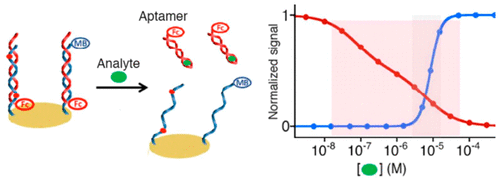当前位置:
X-MOL 学术
›
Anal. Chem.
›
论文详情
Our official English website, www.x-mol.net, welcomes your
feedback! (Note: you will need to create a separate account there.)
Engineering Biosensors with Dual Programmable Dynamic Ranges
Analytical Chemistry ( IF 6.7 ) Pub Date : 2018-01-10 00:00:00 , DOI: 10.1021/acs.analchem.7b04852 Benmei Wei 1 , Juntao Zhang 1 , Xiaowen Ou 1 , Xiaoding Lou 1 , Fan Xia 1 , Alexis Vallée-Bélisle 2
Analytical Chemistry ( IF 6.7 ) Pub Date : 2018-01-10 00:00:00 , DOI: 10.1021/acs.analchem.7b04852 Benmei Wei 1 , Juntao Zhang 1 , Xiaowen Ou 1 , Xiaoding Lou 1 , Fan Xia 1 , Alexis Vallée-Bélisle 2
Affiliation

|
Although extensively used in all fields of chemistry, molecular recognition still suffers from a significant limitation: host–guest binding displays a fixed, hyperbolic dose–response curve, which limits its usefulness in many applications. Here we take advantage of the high programmability of DNA chemistry and propose a universal strategy to engineer biorecognition-based sensors with dual programmable dynamic ranges. Using DNA aptamers as our model recognition element and electrochemistry as our readout signal, we first designed a dual signaling “signal-on” and “signal-off” adenosine triphosphate (ATP) sensor composed of a ferrocene-labeled ATP aptamer in complex to a complementary, electrode-bound, methylene-blue labeled DNA. Using this simple “dimeric” sensor, we show that we can easily (1) tune the dynamic range of this dual-signaling sensor through base mutations on the electrode-bound DNA, (2) extend the dynamic range of this sensor by 2 orders of magnitude by using a combination of electrode-bound strands with varying affinity for the aptamers, (3) create an ultrasensitive dual signaling sensor by employing a sequestration strategy in which a nonsignaling, high affinity “depletant” DNA aptamer is added to the sensor surface, and (4) engineer a sensor that simultaneously provides extended and ultrasensitive readouts. These strategies, applicable to a wide range of biosensors and chemical systems, should broaden the application of molecular recognition in various fields of chemistry.
中文翻译:

具有双重可编程动态范围的工程生物传感器
尽管分子识别已广泛应用于化学的所有领域,但仍然受到明显的局限性:主体与客体的结合表现出固定的双曲线剂量-反应曲线,这限制了其在许多应用中的用途。在这里,我们利用DNA化学的高度可编程性,提出了一种通用策略来设计具有双可编程动态范围的基于生物识别的传感器。使用DNA适体作为我们的模型识别元件,并使用电化学作为我们的读出信号,我们首先设计了一个双信号“信号开启”和“信号关闭”三磷酸腺苷(ATP)传感器,该传感器由二茂铁标记的ATP适体组成,与互补的,电极结合的,亚甲蓝标记的DNA。使用这个简单的“二聚”传感器,我们表明,我们可以轻松地(1)通过电极结合的DNA上的碱基突变来调节此双信号传感器的动态范围,(2)通过使用电极的组合将该传感器的动态范围扩展2个数量级对适体具有不同亲和力的双链,(3)通过采用螯合策略将超信号的高亲和力“耗竭” DNA适体添加到传感器表面,从而创建超灵敏的双信号传感器,(4)设计传感器同时提供扩展和超灵敏的读数。这些适用于广泛的生物传感器和化学系统的策略应拓宽分子识别在化学的各个领域中的应用。(2)通过使用对适体具有不同亲和力的电极结合链的组合,将该传感器的动态范围扩大2个数量级,(3)通过采用其中不进行信号传导的螯合策略,创建超灵敏的双信号传感器。高亲和力的“耗尽型” DNA适体被添加到传感器表面,并且(4)设计可同时提供扩展和超灵敏读数的传感器。这些适用于广泛的生物传感器和化学系统的策略应拓宽分子识别在化学的各个领域中的应用。(2)通过使用对适体具有不同亲和力的电极结合链的组合,将该传感器的动态范围扩大2个数量级,(3)通过采用其中不进行信号传导的螯合策略,创建超灵敏的双信号传感器。高亲和力的“耗尽型” DNA适体被添加到传感器表面,并且(4)设计可同时提供扩展和超灵敏读数的传感器。这些适用于广泛的生物传感器和化学系统的策略应拓宽分子识别在化学的各个领域中的应用。高亲和力的“耗尽型” DNA适体被添加到传感器表面,并且(4)设计可同时提供扩展和超灵敏读数的传感器。这些适用于广泛的生物传感器和化学系统的策略应拓宽分子识别在化学的各个领域中的应用。高亲和力的“耗尽型” DNA适体被添加到传感器表面,并且(4)设计可同时提供扩展和超灵敏读数的传感器。这些适用于广泛的生物传感器和化学系统的策略应拓宽分子识别在化学的各个领域中的应用。
更新日期:2018-01-10
中文翻译:

具有双重可编程动态范围的工程生物传感器
尽管分子识别已广泛应用于化学的所有领域,但仍然受到明显的局限性:主体与客体的结合表现出固定的双曲线剂量-反应曲线,这限制了其在许多应用中的用途。在这里,我们利用DNA化学的高度可编程性,提出了一种通用策略来设计具有双可编程动态范围的基于生物识别的传感器。使用DNA适体作为我们的模型识别元件,并使用电化学作为我们的读出信号,我们首先设计了一个双信号“信号开启”和“信号关闭”三磷酸腺苷(ATP)传感器,该传感器由二茂铁标记的ATP适体组成,与互补的,电极结合的,亚甲蓝标记的DNA。使用这个简单的“二聚”传感器,我们表明,我们可以轻松地(1)通过电极结合的DNA上的碱基突变来调节此双信号传感器的动态范围,(2)通过使用电极的组合将该传感器的动态范围扩展2个数量级对适体具有不同亲和力的双链,(3)通过采用螯合策略将超信号的高亲和力“耗竭” DNA适体添加到传感器表面,从而创建超灵敏的双信号传感器,(4)设计传感器同时提供扩展和超灵敏的读数。这些适用于广泛的生物传感器和化学系统的策略应拓宽分子识别在化学的各个领域中的应用。(2)通过使用对适体具有不同亲和力的电极结合链的组合,将该传感器的动态范围扩大2个数量级,(3)通过采用其中不进行信号传导的螯合策略,创建超灵敏的双信号传感器。高亲和力的“耗尽型” DNA适体被添加到传感器表面,并且(4)设计可同时提供扩展和超灵敏读数的传感器。这些适用于广泛的生物传感器和化学系统的策略应拓宽分子识别在化学的各个领域中的应用。(2)通过使用对适体具有不同亲和力的电极结合链的组合,将该传感器的动态范围扩大2个数量级,(3)通过采用其中不进行信号传导的螯合策略,创建超灵敏的双信号传感器。高亲和力的“耗尽型” DNA适体被添加到传感器表面,并且(4)设计可同时提供扩展和超灵敏读数的传感器。这些适用于广泛的生物传感器和化学系统的策略应拓宽分子识别在化学的各个领域中的应用。高亲和力的“耗尽型” DNA适体被添加到传感器表面,并且(4)设计可同时提供扩展和超灵敏读数的传感器。这些适用于广泛的生物传感器和化学系统的策略应拓宽分子识别在化学的各个领域中的应用。高亲和力的“耗尽型” DNA适体被添加到传感器表面,并且(4)设计可同时提供扩展和超灵敏读数的传感器。这些适用于广泛的生物传感器和化学系统的策略应拓宽分子识别在化学的各个领域中的应用。











































 京公网安备 11010802027423号
京公网安备 11010802027423号